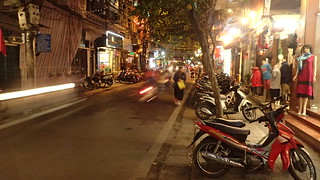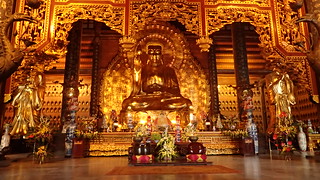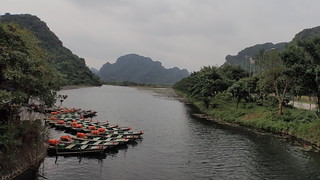Sitting in my seat on Vietnam Airlines flight number 836 destined for Hanoi, I reflect on the last few days spent in Siem Reap… after our Angkor Wat tour the previous day, Saffron and I had dinner at the hostel then set off with a group of fellow travelers to enjoy a night on the town. We head north and are soon inundated with the pulse of Pub Street. Once the sun sets, Pub Street transforms from sedate shopping district to a raucous hedonist’s wet dream. I’ve been to this rodeo before and felt it best left to the younger crowd. I bid farewell to all and worked my way through the throng, repeatedly asked if I’d like a drink, drugs and more. A well weathered middle age prostitute adorned in a long bright red dress offers a proposition; “I go with you” followed by my quick reply, “No, you don’t.” I spent the evening back at the hostel sipping a couple cold beers while watching The Killing Fields in the complex’s theater. Riveting! Next day, Saffron and I treat ourselves to $6 one hour full body massages after which I head over to a cooking class and she soaks her bare feet in a tank of hungry small fish, eager to gnaw the dead flesh from her toes. On the way to the airport, we make a brief stop at the Life And Hope Sewing Center to pick up a hand made dress she was measured for the previous day.
A few minutes before sunset, our plane taxis to the runway under high overcast. With wheels up, a descending grey landscape reveals a surprising amount of reflected water below, vegetation appearing as numerous spiky sponges floating in a bowl. Clouds are soon breached, red strobe flashing off white wings, below is a black abyss but it’s impossible to tell if it’s from cloud cover or simply the remoteness of the region. Northeast Cambodia is mostly jungle with little population or infrastructure. An hour and forty minutes later the vast glow of Hanoi appears and we quickly pass through customs. Departing the airport terminal we walk left and wait at column #1 for the #86 bus to the Old Quarter of Hanoi. A tout approaches and tries to sell a cab ride to our stay at the Hanoi 3B Hotel, 17 miles south. But the bus is modern, air-conditioned and only $1.35 so we waited a few minutes for it to arrive. Once aboard an elderly gentleman asked if I was from the United States and I gave a nod. His English was conversant and he wished us well on our travels. Otherwise, no other passengers paid us much attention. Cruising over a wide well lit divided highway a wall mural appears near the city limits. Beautifying a protective dyke along the Red River, The Hanoi Ceramic Mosaic Mural adorns the roadside for 4 miles and was completed in 2010. It’s recognized as the world’s largest ceramic mural – beautiful. Using the OsmAnd+ navigation app on my Android, I’m monitoring progress to a preloaded waypoint (bus stop) near our hotel. It comes and goes but the bus doesn’t stop. A short distance later it does and we step out into the night for a short walk to our quarters on Ma May Street.
The Hanoi 3B Hotel is located in the Old Quarter of Colonial Hanoi. Snug, narrow four story buildings look more at home in the Netherlands than here. Businesses occupy ground floors with residences atop, laundry draping on balconies. Despite the short building stature, the Old Quarter claims one of the most densely populated areas of the world. Winding streets are narrow, filled with ubiquitous scooters and sidewalks wide but like everywhere in Vietnam, they’re not really pedestrian walking paths. Rather sidewalks are used to park scooters, display vendor wares, grow trees for shade and to provide chairs and tables for diners. In other words, an obstacle course with one frequently walking the gutter when forced from the sidewalk.
Check-in at the hotel is straightforward. A small waiting area overlooking the street is shared with reception, followed by a hallway leading to stairs ascending to rooms and, further back, a breakfast dining room. We’re in a six bed mixed dorm for $8 per night with a made to order breakfast included each morning. Like every other lodging establishment we’ve stayed, this hotel is also part travel agent, eager to assist with any needed nearby excursions. Leafing through a few brochures, we signed up for a $43 day trip on Thursday to two attractions 60 miles south: the Bai Dinh Temple and a float trip along a river at Trang An.
Once awake Wednesday morning, we find a cold front has pushed into the area bringing cool overcast with scattered showers. We stopped at a clothing shop near our hotel where Saffron purchased a light Columbia jacket then set off for the Ho Chi Minh Mausoleum but it was already closed when we arrived at 11:00 am. This was especially disappointing because we inquired with hotel staff and were assured the attraction would be open until noon. A large grey monolith, the mausoleum has two soldiers clad in white uniforms standing guard at the entrance. A wide walk surrounds the building, separating the parking area from the structure. The guards’ apparent main purpose was to shoo anyone stepping onto the walk away. Strange.
After a strong cup of warming coffee we walked to the Military History Museum and found static displays and information much better than the War Remnants Museum in Saigon. History of regional warfare is on display, dating back hundreds of years with weapons and gear used along with dioramas of solders in the field. By far, the museum was focused towards the history of the war with The United States of America, i.e. The Vietnam War, during the 1960s. Several floors of the museum show hundreds of photos and propaganda posters in relation to the war. Waves of students on field trips made their way through exhibits showing the atrocities committed against their families and countrymen by the American military forces. Western tourists too stand, mortified, staring at the photos, hands over their mouths, hardly able to fathom The Monster capable of napalm bombs and chemical agents rained upon innocent civilians. It was fascinating to glimpse the Vietnamese perspective of the war through their eyes: In one corner – America the ruthless, inhuman villain and in the other – Vietnam, the poor peaceful pacifist Dove, incapable of unspeakable acts. One poster in particular caught my attention. Black and white drawings, similar to a cartoon, depicted a series of stills showing how farmers should treat any U.S. Airmen encountered who were shot down. They were to be fed, sheltered and well cared for before being turned over to the Viet Cong. So they’d be in great condition to endure brutal relentless torture no doubt! Ask Arizona Senator John McCain about it. He was held as a Prisoner of War at the infamous Hanoi Hilton prison for 5 ½ years and his treatment was less than compassionate to say the least. Those small details of the Dove’s behavior towards a defenseless enemy were noticeably absent. “Only angelic halos for us, thank you.” Such is the nature of history and who gets to tell the tale. Outside, a large courtyard, filled with procured American military hardware, much in restored condition, shares space with a national monument; the 31 meter tall Hanoi Flag Tower with a staircase leading to impressive views up top.
Thursday morning has us boarding a tourist van for the 60 mile, 2 hour ride south to the Bai Dinh Temple, a sprawling complex covering 2.7 square miles. The van arrives and we scamper out into light drizzle to greet other passengers already within. We pick up a few more from area hotels then set off for our destination. Traveling the highway once again we see our first signs of law enforcement within Vietnam; unarmed cops dressed in camel brown uniforms standing on the shoulder waving white batons to catch motorists’ attention to pull over. Gazing into the landscape, it’s noticed that all buildings are made of either concrete, brick or both. Not a single structure is seen made entirely of wood. Urban sprawl is the norm here. Imagine linear towns that retreat a hundred meters from main thoroughfares and you get the idea. As a result, traffic congestion is constant and travel is slow.
We arrive at the Bai Dinh Temple and our guide procures our tickets. Battery powered trams carry visitors from the parking area to the main complex. Our guide, waving a yellow triangular flag, gathers our group and we begin our tour. Not much information is provided from the guide; he’s there to simply keep pace and ensure the ducklings don’t wander as we do have to depart in a few hours to re-board the van for the river float portion of the trip. Not that he could provide much information or history anyway. This complex was built by a cement baron upon an old temple with construction starting in 2003 and completed in 2010. Everything about this place is BIG; the size of structures, a massive bell, the number of ostentatious Buddhas, an enormous reflecting pool, the land area itself. After a while, an insincere authenticity is realized; pointedly, where are the monks? We’ve been here for over an hour and have covered long distances, entering many buildings and not one has been seen. It would not be a stretch to imagine we are within Disney World Pagoda Temples Park looking forward to an ensemble of Mickey Monks performing The Dancing Buddhas routine. The Bai Dinh Temple is beautiful and vast but not traditional. There is no reason to have a guide and can be done without provided you can manage transportation to the site.
Seven miles southeast of the temples lie the Trang An Boat Tour docks. A visually stunning unspoiled natural landscape comprised of a soft limestone karst system surrounding a meandering river and fertile plains awaits. Visitors are led over a small bridge to waiting guides and their tangle of small vessels. Orange life vests are provided as we board a traditional sampan along with another couple and oarsman seated at the stern. We shove off and gently meander over nearly still water towards cave pocked forest covered low hills. As we approach, the river penetrates a hill and we enter a long narrow tunnel to traverse the space. Watch out for low overhangs to avoid a serious crack to the head! This is repeated numerous times with artificial lights providing luminescence on longer spans. There is a serene stillness here, made possible since there are no motors used for propulsion. Our oarsman rows the sampan with two short oars, occasionally shifting from hands to feet to relax weary muscles. Though the area itself is pristine, the sheer number of boats conveying tourists can be huge. Today is overcast, breezy and cool so numbers are low. But I can imagine during peak days, it might be possible to walk across the river from boat to boat. Still, this is a unique area unlike any I’ve seen and well worth the trip.
Tomorrow we set off for a three day / two night journey to one of the most popular natural wonders of the world: Ha Long Bay.























